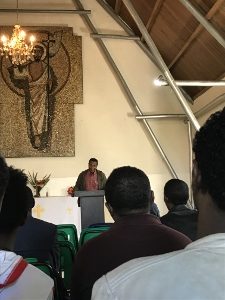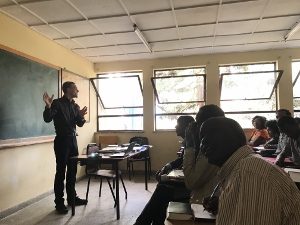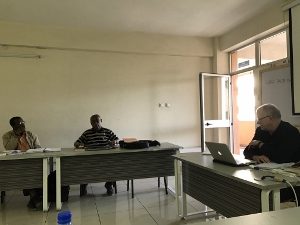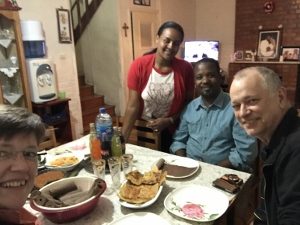Staffan and I joined the morning prayer at the Mekane Yesus Seminary (MYS), which is about a half-a-kilometer away from the guest house. It was quite empty when we arrived at 8:00 am, but it was very full by the time it ended.

I visited Elias’ New Testament class (8 of the 26 students were women). Elias is a Swedish Evangelical Mission (SEM) missionary, who is here with his wife (a linguist who is continuing her studies here) and his 4 boys (2 sets of twins!!!!). Elias had a small digital projector, about the size of large paperback book, to show some maps and ancient inscriptions. There was some good discussion about the title “apostle” which Paul uses. Some of the Pentecostal and African independent churches are using the title “apostle” in their ministries. It was identified in the student comments that this is outside the witness of Scripture and the tradition of the church. They were concerned that this represented a seeking after a title and power rather than the calling to sacrificial service—even unto death—that was modeled by the apostles in the Bible. Interestingly, I heard yesterday from the 2 PhD women (who were also disapproving of the claim of apostle), that there was also a higher title of “super apostle” and then the highest being “man of God.” I asked if the super apostles get a cape. With the inflation of titles, yes, the next one would be “superman of God!”

After class, I had tea with Elias to hear a bit of his story. He had studied at Johannelund for his pastor’s training! I asked him what keeps him coming back to Ethiopia. He mentioned three things. First, he said he really enjoyed teaching with such eager students. At the beginning the English language capacity of most students is very low, so it is a challenge, but by the third year it is adequate to good, with some very good in English. It is national law that higher education is in English. (Elias is fluent in Amharic.) Secondly, he mentioned, “The Gospel joy is somehow more present here.” This isn’t romanticized, as he knows the struggles here, but there is something special here—and I have sensed it too. (I think I began to understand it a bit more after sitting in Staffan’s class in the afternoon. See below.) Third, he said there is something else that is both good and bad. The reality is that so many things don’t work, things are cheaply made and break, it is difficult to get repair people out to fix things after several contacts, BUT he likes to fix things! And he is pretty good at it. I told him my missions prof (Pat), said that a handyman on the mission field was worth 5 pastors, and you are both! How perfect! When I mentioned this to Staffan, he told of a time that a whole bunch of missionaries were forced to leave, and the only one that the locals asked about was the one who fixed cars.
Staffan arrived to fetch me, and we head over to EGST for lunch. We joined one of the Korean missionary teachers. They have been in Ethiopia since the mid 90’s but at EGST for two years. His partner in mission (outside of his EGST teaching) is a lay pastor who previously planted 15 churches! Yup, that is he alone planted 15 churches! One story, if I understood correctly, grew from a few meeting in a grass hut to 1,000 members in something like 1 year! This is Ethiopia. The Lutheran church, Mekane Yesus, grew 24% since 2013 to 7.9 million members today!!!
We grabbed some tea in the staff lounge after lunch (which is free). On my way out, a man came up to me and started asking about generational curses. He had heard that I had a class session on this topic. I was wondering if I was going to be referred to as “the curse lady.” We talked about the texts and a short summary of the message that centers on how generational curses in the Pentateuch are to be first a deterrent in order to keep the ancient Israelites in the blessings of the covenantal relationship. If they fail in prevention, then the curses are a wakeup call from God to repent and be reconciled back to a right relationship with God; the key understanding is that of stimulating reconciliation. So, I hope the message was relayed. I would much rather be the reconciliation lady than the curse lady! Generational curses are, indeed, a hot topic.
Then, I was off to Staffan’s class on theology of mission. Four students (male) were presenting their papers on a person who has been involved in mission or evangelism in Africa.

Three researched Ethiopians, and one researched Desmond Tutu. Not only did I hear the stories of three Ethiopians who were previously unknown to me, I learned more about some of the horrible challenges they faced in the recent history of Ethiopia. The blood of the martyrs is the seed of the church. One faithful man in the midst of persecution, Gudina Tumsa, is called both the “Billy Graham of Ethiopia” and the “Bonhoeffer of Ethiopia.” He was killed in 1979 during the Marxist years.
It is important to mention that the growth of the church in Ethiopia is hugely due to the indigenous Christian leaders, even from the early years. Onesimos made a Bible translation (from Swedish and German texts) into the Oromo language in 1899. (Onesimos learned Swedish at Johannelund, though an earlier campus!) Because Haile Sailasse privileged the Eastern Orthodox, no other Bible translation other than the one in the Amharic language was allowed by law. It was in 1974 that a new Oromo Bible translation was made from the Hebrew and Greek.
My first awareness of the country of Ethiopia was from 1973, during the Sailasse years, when there was a devastating famine. There was another terrible famine in 1983-84, where over 1 million people died in the norther areas. The Marxist regime forbid people from traveling up there, in order to try to not let it be known how bad things were. It was also under the Marxist regime that there was great oppression of Christianity. Many were imprisoned. Many were killed, like Gudina. In spite of this, the church grew and developed a church foundation that understood the cost of discipleship. There is indeed a “Gospel joy” here, after having lived through such dark times just a short while ago.
Staffan’s research indicates that the denominational boundaries increased after the missionaries returned after the fall of communism. Prior to that, Christians were persecuted together. Staffan told of a time he saw an evangelical pastor and an Orthodox priest greet each other with a warm hug, which is quite unusual. When he asked the pastor, Staffan heard, “We were together in prison for three years.”
The evening closed with dinner next door at Teshoma’s house. Teshoma is a part-time PhD student at the School of Mission and Theology (now VID Specialized University) in Stavanger, Norway. So, we met in Norway! It was wonderful to meet his family, with his lovely wife and three girls (including a set of twins).

Teshoma was a full-time PhD student, but he was elected the general secretary (I think this is accurate) of the Mekane Yesus church (yes, overseeing 7.9 million members). I learned tonight that his father was killed during the Marxist time. Again, a reminder of the Gospel joy now, because it is grounded in the hope-filled promise of the resurrection.
With blessings,
Beth
Your blogs sing to my heart. Thank you for sharing your life with us.